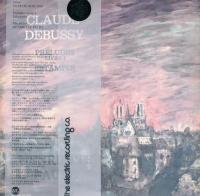Electric Recording Company Reissues Rare Henriette Fauré Debussy Record
How obscure is Ms. Fauré? Do a web search and virtually nothing comes up. You'll find that her greatest claim to fame is that she studied with Maurice Ravel and was one of the first artists to extol the virtues his music and play them in public.
She also studied at the Paris Conservatoire under Louis Diémer, one of the leading exponents and most accomplished pianists of the French school at the turn of the 20th century. You won't find a biography or discography online though, so I can't tell you anything about her other than that because of her association with Ravel, her interpretations of his music are considered by some to be definitive and the few records she made, particularly those of Ravel's music, are sought after and in short supply.
This one, however is of her playing Debussy. Still original copies of this record too are pricey. In 2006 a copy went for $1077, in 2010 one went for $1592 and in 2014 one went for $1539.99. Clearly piano aficionados or Fauré cultists clamor for these records.
In other words, ERC's price of £300 (around $500) for a brand new copy, cut from the original master tape using its completely restored all-tube vintage Lyrec/Ortofon cutting system and packaged in a jacket difficult to distinguish from an original and limited to 300 copies, begins to sound reasonable compared to the cost of a less than perfect used original.
The question is are the collectors buying because of rarity or because of an exceptional performance and possibly great sound? To state the obvious, I am not a classical music expert or a connoisseur of either solo piano performers or their recordings. I did find a reviewer who described her playing of Ravel at least as "metronomic" (she claimed Ravel insisted she stay on tempo). As a player the reviewer wrote "while Faure is no Martha Argerich or Ivo Pogorelich (there are a fair number of wrong notes here and there), it is fascinating to hear her play this (Ravel's) music." At least I know who is Pogorelich!
What I think I do know something about is good recorded sound and the sound of the stereo record is absolutely stunning—about as non-mechanical, non—recorded piano sounding a piano recording as I've heard. The profusion of tonal colors overwhelms. Dynamics, both micro and macro are impressive for any era but particularly fora recording of this vintage.
The piano image hovers eerily rock-solid in three-dimensional space in as non-mechanical a state as I've ever heard a piano recording. The image has great solidity and believability floating above a dead black backdrop produced by a superbly quiet, perfectly centered pressing.
As for Ms. Fauré's performance of the short "Estampes", I found it mesmerizing and hypnotic. French musical impressionism is much like its visual counterpart—more textural and and colorful than physically solid. If you're familiar with Debussy's "La Mer" you'll have an idea of what to expect. The piece is broken down into three parts: the first is evocative of Chinese or Japanese music, the second hints of Spanish influences and the third is supposed to suggest a thunderstorm in a French garden.
"Préludes, LIvre I" includes the first 12 of 24 preludes written between December 1909 and February 1910. The tempi are slow and deliberative, the moods set delicate and introspective.
A delicate recording like this, produced with a mid-hall perspective and meant to be heard at relatively low volume to be convincing demands a quiet pressing with silent backgrounds. The Record Industry pressing provides that.
However, dynamics are extremely wide, going from "p" (piano)-soft to "f" (forte)-loud. It will take you by surprise so don't start at a higher than realistic level—that is if you are willing to sped $500 to own a copy. You can search YouTube and find performances of the music to find out if you like it. I guaranty you'll love the sound of this reissue and if you like to listen to solo piano music recordings (I do), this is one that you'll play all the way through every time.


